Micro-impulse and plasma plume produced by irradiating aluminum target with nanosecond laser pulses in double-pulse scheme
Chenghao YU(于程浩),Jifei YE(叶继飞),Weijing ZHOU(周伟静),Hao CHANG(常浩)and Wei GUO(郭威)
State Key Laboratory of Laser Propulsion&Application,Department of Aerospace and Technology,Space Engineering University,Beijing 101416,People’s Republic of China
Abstract The micro-impulse generated by ablating an aluminum target in double-pulse laser bursts with different interpulse delays was investigated using a torsion pendulum.The plasma plume was simultaneously visualized using high-speed photography to analyze the coupling mechanism of the ablation impulse.The experiment was carried out using a pulsed laser with a pulse width of 8 ns and a wavelength of 1064 nm.The experimental results show that an impulse with an interpulse delay of 60 ns is roughly 60% higher than that with no delay between the two pulses,when the energy of both laser pulses is 50 mJ.Therefore,double-pulse schemes could enhance the ablation impulse under certain conditions.This is because the ablation of the first laser pulse changes the optical properties of the aluminum target surface,increasing the absorptivity.However,the ablation impulse is reduced with a time delay of 20 ns when the energy of both laser pulses is 100 mJ or 150 mJ.It can be concluded that the plasma produced by ablating the aluminum with the first pulse shields the second laser pulse.To summarize,the experimental results show that different delay times in a double-pulse scheme have a significant effect on the ablation impulse.The study provides a reference for the optimization of the parameters when laser ablation propulsion with a double-pulse scheme is applied in the fields of space debris removal,laser ablation thrusters,and so on.
Keywords:laser ablation,double pulse scheme,impulse enhancement,aluminum plasma plume,fast photography
1.Introduction
Laser ablation propulsion(LAP)uses the recoil force caused by laser ablation for noncontact manipulation in space[1].When an intense laser pulse irradiates the target,the surface material of the target melts,evaporates and even generates a plasma plume[2,3].Then the plasma plume,with high temperature and pressure,expands away from the target surface at high speed.According to the conservation of momentum,the target will be provided with the recoil force of expansion[4].LAP provides a promising solution for space debris removal[5],detumbling noncooperative targets[6],and other popular space applications[7].Although a large amount of research has been carried out on the characteristics of the micro-impulse produced by laser ablation,previous studies on the coupling mechanism of ablation impulses most focus on the laser parameters(laser spot size[8],laser pulse duration[9]),incident angle[10],ambient air pressure[11],and materials[12].As laser ablation involves a variety of physical processes,it is difficult to analyze the impulse formation mechanism in depth by studying the macroscopic mechanical properties alone.In recent years,in the field of laser-induced breakdown spectroscopy(LIBS)which is a famous approach used for qualitative and quantitative elemental analysis of materials,it has been found that the double-pulse mode could significantly enhance the intensity of plasma radiation[13].The first laser pulse in the double-pulse method produces a plasma plume after ablating the target.The delayed second laser pulse can interact with the plasma and the target surface to increase the emission intensity[14].Although there are several common configurations of doublepulse LIBS,from a practical perspective,the collinear doublepulse structure is a simple and efficient way to implement a double-pulse ablation[15].Tognoniet alsystematically introduced the basic mechanism of signal enhancement in ns double-pulse LIBS[16].Cremerset alapplied the laser double-pulse technique to the analysis of the spectral characteristics of elemental components in transparent liquids[17].They demonstrated that the emission intensities of elemental constituents were enhanced significantly.Colaoet alfound that the double-pulse technique could significantly improve the analytical capabilities of LIBS for solid targets by comparing double-pulse excitation and single-pulse excitation[18].The plasma emission produced by the double-pulse laser ablation is indeed more intense and lasts longer than the corresponding emission generated by a single laser pulse.In addition,Cristoforettiet aldemonstrated that the interpulse delay time between the two laser pulses has an important influence on the LIBS technique[19].Since the double-pulse mode could enhance the radiation intensity of the plasma plume,this mode may have an effect on the ablation impulse of the pulsed laser.However,there are few studies on the characteristics of the ablation impulse with doublepulse mode.
In this study,we focus on the influence of the interpulse delay time with the double-pulse scheme on the microimpulse characteristics of nanosecond pulsed lasers irradiating an aluminum target in vacuum.The expansion of the plasma plume formed by laser ablation is an important process for inducing mechanical effect.Therefore,the connection between the impulse and the plasma plume is critical in understanding LAP performance.A torsion pendulum was used to measure the impulse produced by laser ablation with the double-pulse scheme,and a fast intensified charge coupled device(ICCD)was simultaneously used to visualize the plasma plume evolution at various delay times.Furthermore,combined with plasma plume injection,the impulse coupling mechanism of the pulsed laser irradiated aluminum target is analyzed.
2.Experimental setup
The double-pulse experimental system is shown in figure 1.The system,which was tested in a vacuum chamber at a pressure of 10−3Pa,could simultaneously measure the ablation impulse and take photographs of the plasma plume.The time-delayed laser pulses generated by two separate lasers(neodymium:yttrium-aluminum-garnet,Nd:YAG)were employed to ablate an aluminum target(Al 1050 purity>99.5%).The wavelength of the laser was 1064 nm and the pulse width(full width at half maximum)was 8 ns.A 50% transmitting/50% reflecting beam splitter was used to spatially superimpose pulses from the two lasers to a high degree of accuracy.In order to ensure the accuracy of the laser energy,an energy meter(FieldMax,Coherent)was used to measure the energy in front of the target surface before and after the test.The beams were focused by anf=77 mm laser focal lens(GCO-150123,Daheng Optics)placed inside the chamber and the distance from the focusing lens to the target surface remains constant.The relative energy distribution of laser I and laser II with a roughly Gaussian radiance profile was measured by the high-resolution laser beam profiling system(LaserCam-HR II,Coherent)shown in figures 2(a)and(b).In addition,figures 2(c)and(d)show the typical ablation spots generated by the focused laser I and laser II beams irradiated onto the aluminum target observed by an optical microscope.In the experiment,the laser energy of each pulse was respectively chosen to be about 50 mJ,100 mJ and 150 mJ,and the corresponding ablation spot diameters with uncertainty are shown in figure 3.Moreover,the laser fluences calculated from the laser energy and the spot size are placed with arrows in figure 3.
The crucial step is the control of the delay time between the two laser pulses.As shown in figure 1,a high-speed infrared photoelectric detector is placed on the side of both laser beams.The detected signals are presented on an oscilloscope to calibrate the interpulse time delay,and the typical measurement of delay time is shown in figure 4.The interpulse delay time is controlled by a digital delay pulse generator(DG645,Stanford Research Systems).The DG645 is also used to trigger two lasers and the ICCD camera(TRC311-S-HQB,Intelligent Scientific Systems).The telecentric lens(TV-1M-800,Opto Engineering)assembled in front of the ICCD was used to visualize the plasma plume structures.The magnification of the telecentric lens is one-fold and the working distance is 800 mm.Changing the delay time between the laser and the ICCD enables the images of the plasma plume to be temporally resolved.
The torsion pendulum could be used to measure the impulse of the aluminum target irradiated by double pulsed lasers[20].The top view of the pendulum is shown in the dashed box in figure 1.The impulse makes the horizontal torsion pendulum move in simple harmonic motion with the pivot as the axis.The rotation angles of the pendulum arm can be indirectly measured by a displacement sensor.Typical rotation angles for the torsional pendulum are shown in figure 5.The detailed principles of micro-impulse measurement with a torsion pendulum are described in[21]and[22].According to the principle of micro-impulse measurement of torsional pendulums,the impulseIcan be expressed as[21]:

where the symbolsLfdenotes the arm of force.The symbolsJ,ωn,and ζ respectively indicate the moment of inertia,the inherent angular frequency,and the damping ratio.θmaxis the maximum rotation angle after the double-pulse laser ablating the aluminum target.The calibration results of the torsion pendulum parameter are shown in table 1.
3.Results and discussion
3.1.Micro-impulse characteristics
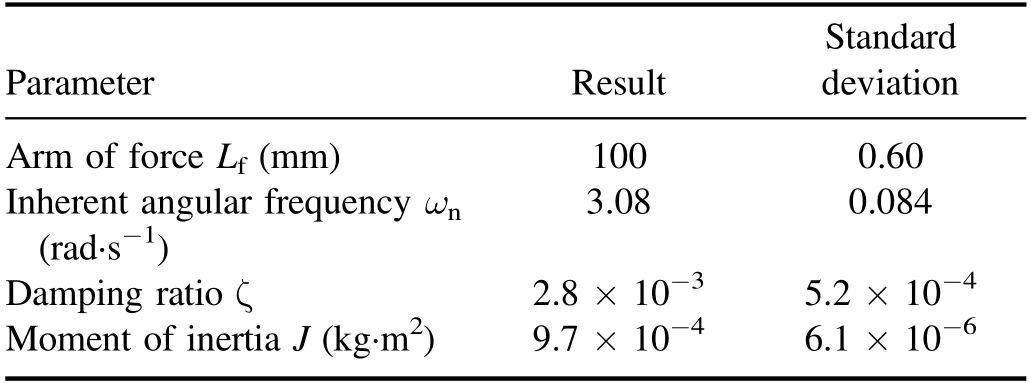
Table 1.Typical operation parameters.
Figure 6 shows the variation in ablation impulse generated by double pulses with various interpulse delay times,and the emitting energy of each laser pulse is 50 mJ.As shown in figure 6,when the delay time is 0 ns,indicating that two pulses reach the aluminum target simultaneously,the impulse is 1.64 μN·s.With delay time increasing,the ablation impulse increases rapidly at first but decreases sharply when the interpulse delay time is longer.To be more specific,the ablation impulse reaches its maximum at the delay time of around 60 ns,which is approximately 60% higher than its 0 ns counterpart.Since the experiment was carried out in vacuum,the enhancement in impulse produced by doublepulse laser ablation may be due to thermal effects acting on the target surface.Krstulovic and Milosevic discovered that the ablation threshold gradually decreases during continuous ablation as the target surface is progressively heated[23].The ablation crater volume as a function of double-pulse laser delay time was investigated by Maoet aland its trend was similar to that of the impulse with interpulse delay time in figure 6[14].Maoet alobserved that the crater volume reaches a maximum,increasing approximately five-fold with increased delay time,which means enhanced coupling of laser energy to the target[14].Moreover,as the temperature of the aluminum target surface increases,the reflectivity of the aluminum target surface decreases which means the aluminum target will absorb more laser energy[23,24].However,as shown in figure 6,the ablation impulse decreases to around its 0 ns counterpart at the delay time of 120 ns.The reduction in impulse as delay time increased to 120 ns represents the ablation using two separated pulses that do not affect each other.
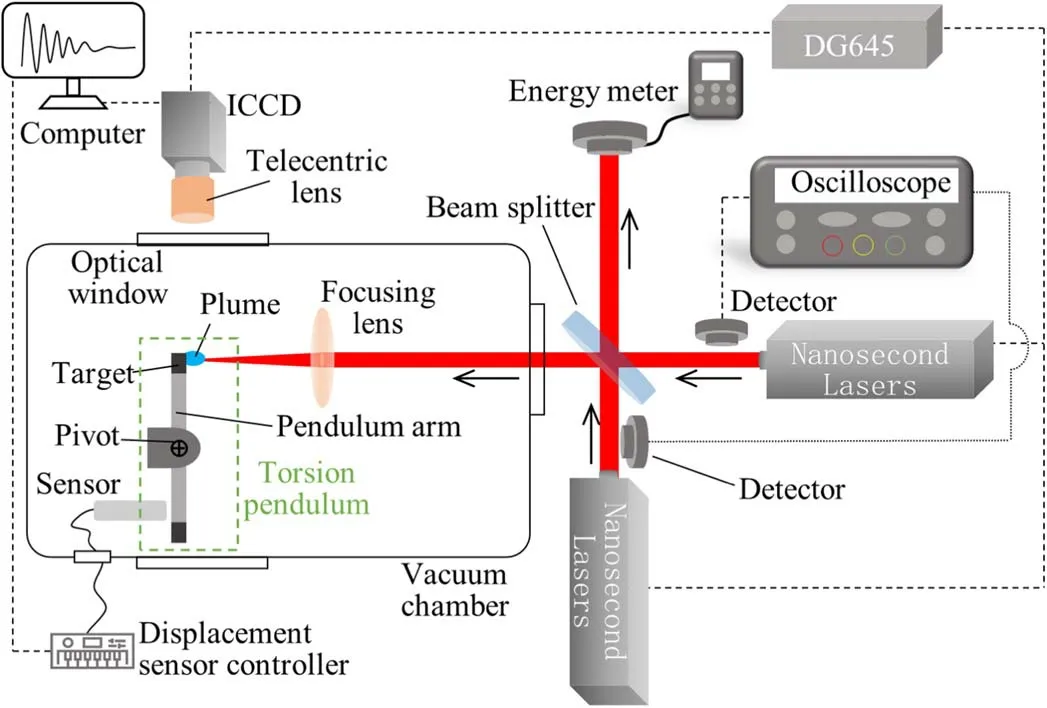
Figure 1.Schematic diagram of laser ablation with double pulses.The part labelled DG645 represents the digital delay pulse generator.

Figure 2.(a)and(b)show the normalized relative energy distribution of laser I and laser II,respectively,with a roughly Gaussian radiance profile which has a circular shape.(c)and(d)represent the ablation spots generated by the focused laser I and laser II beams,respectively,irradiated onto the aluminum target with typical laser energy.
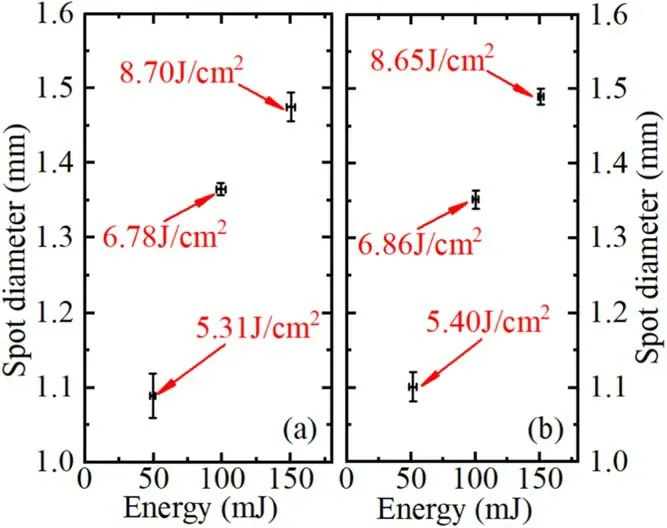
Figure 3.(a)and(b)show the spot size generated by laser I and laser II,respectively,with different laser energies selected in the experiment.The laser fluences calculated from the laser energy and the spot size are placed with arrows in the diagram.

Figure 4.Typical measurement of delay time between two pulses.

Figure 5.Typical rotational angles of the torsion pendulum.

Figure 6.Variation in impulse with delay time,where each laser pulse is 50 mJ.
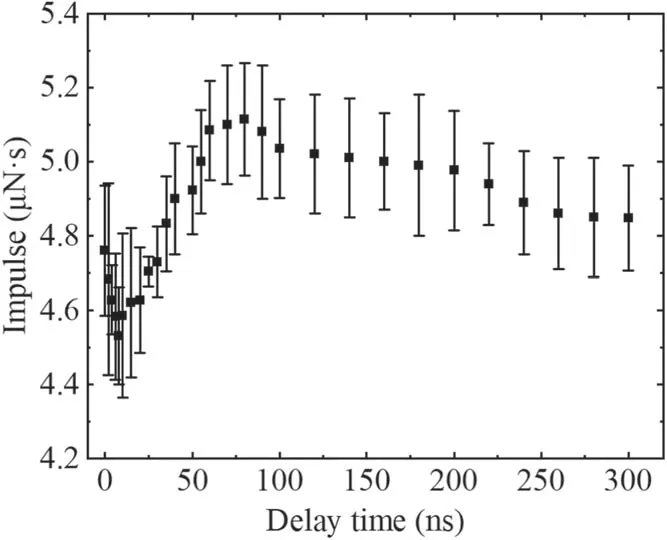
Figure 7.Variation of impulse with the delay time,where the energy of each laser pulse is 100 mJ.

Figure 8.Variation in impulse with the delay time,where the energy of each laser pulse is 150 mJ.
Figure 7 shows the variation in the ablation impulse with delay time,where the energy of both laser pulses is 100 mJ.The impulse first decreases with the delay time before 20 ns.This is probably because the intense plasma plume produced by the ablation of the first laser pulse has not yet expanded and absorbs the major energy of the second laser pulse through electron-ion inverse bremsstrahlung(IB)[25].As a result,not all of the laser energy reaches the surface of the aluminum target,reducing the total laser energy absorbed by the target,which is known as the plasma shielding effect[16].But the impulse increased approximately 8% more than its 0 ns counterpart as the delay time changed from 20 to 80 ns.This is due to the decrease in target surface reflectivity caused by the increase in temperature contributing to the ablation rate[24].

Figure 9.Time-resolved image of the plasma plume with the double-pulse scheme,where the energy of both laser pulses is 50 mJ.

Figure 10.Time-resolved images of the plasma plume with the double-pulse scheme,where the energy of both laser pulses is 100 mJ.
In the situation where the energy of both laser pulses is 150 mJ,the variation of the ablation impulse with delay time is given in figure 8.It can be seen that the trend in figure 8 is similar to that in figure 7.The maximum appears at a delay time of around 100 ns,which is about 9%higher than that of 0 ns.The enhancement of plasma radiation may cause an improvement in the ablation impulse.Maoet alobserved a dramatic increase in the silicon emission line Si at 288.16 nm at approximately 100 ns delay between laser pulses[14].In addition,the temperature and the electron number density observed by Maoet alalso changed abruptly when the interpulse delay time was about 100 ns.
3.2.Plasma plume characteristics
The expansion of the plasma plume causes the aluminum target to receive a recoil impulse.Laser absorption by the plasma plume and plasma expansion are also the main mechanisms impacting the properties of double-pulse ablation.The mechanisms for impulse enhancement may be explained by changes in the plasma plume properties.Therefore,the study of the plasma plume characteristics is important for the analysis of the coupling mechanism of the ablation impulse in the double-pulse scheme.In this work,the plasma plume was observed using high-speed photography as the impulse was measured at the same time.The ICCD gate width was set to 5 ns.The time sequences between the camera and laser were controlled by the DG645,which enables the capture of different momentary patterns of the plasma plume.
Time-resolved plasma plumes for delay times of 0 ns,60 ns,and 120 ns are given in figure 9,where the energy of both laser pulses is 50 mJ.As seen from figure 9,when the delay time is 0 ns,that means the two laser pulses reach the surface of the aluminum target at the same time,which triggers physical processes such as scattering,reflection,and absorption[3].When the interpulse time delay is 60 ns,the first laser pulse reaches the surface of the aluminum target and ablates it to produce the plasma plume.At 60 ns,before the former plasma plume disappears,the second laser pulse reaches the target surface,producing a stronger jet of the second plasma plume,and the second plasma plume was larger and more luminous than the plume when the delay time was 0 ns.There may be two reasons for this.The first cause is the interaction between the second laser pulse and the plasma produced by the first laser pulse ablation.The plasma plume absorbs partial energy of the second laser pulse through inverse bremsstrahlung(IB)[25]and undergoes further ionization,producing high temperature and density plasma.The second possible reason is that the heating of the first laser pulse,which changes the optical properties of the target surface,may lead to a lower reflectivity and ablation threshold,increasing the laser ablation efficiency and enhancing the coupling of laser energy to the target[23,24].As a result,when the remaining energy of the second laser pulse reaches the target surface,a second plasma plume is formed,of which the radiation intensity is stronger and the duration is longer.The expansion of the plasma plume formed by laser ablation is an important process in inducing mechanical effect.Therefore,the impulse with the delay time of 60 ns is roughly 60% higher compared to the 0 ns delay time impulse in figure 6.When the delay time is 120 ns,the plasma plume produced by the first laser pulse ablation disappears completely before the second laser pulse reaches the target surface.The second plasma plume has no significant enhancement effect to impulse compared to that at the delay time of 0 ns.
Time-resolved plasma plumes for delay times of 0 ns,20 ns,and 80 ns are given in figure 10,where the energy of both laser pulses is 100 mJ.It can be seen that the radiation of the plasma plume obtained by ablation is pretty intense when the delay time is 0 ns.An extremely strong ‘plasma nucleus’appears close to the target surface at 20 ns after the pulse starts[8].When the delay time is 20 ns,the radiation of the plasma plume is significantly weaker than those obtained at the delay time of 0 ns.This may be the shielding effect of the plasma produced by the first laser pulse ablating the aluminum target.Due to the short time interval between the two laser pulses,the second laser pulse does not directly ablate the target surface.Instead,it is intercepted by the initial intense plasma,which has not been allowed to expand yet,formed by the laser ablation of the first laser pulse.As a result,the ablation impulse is slightly reduced when the double-pulse delay is 20 ns in figure 7.When the delay time is 80 ns,the second laser pulse reaches the place near the target surface only at the later stages of the propagation of the plasma plume generated by the first ablation.Only less energy of the second laser pulse interacts with the plasma and promotes further ionization of the plasma plume.Then,the subsequent laser energy reaches the target surface.Due to the decreased reflectivity and ablation threshold of the aluminum target surface resulting from the increase in the surface temperature produced by the first pulse,which in turn increases the laser ablation efficiency,the second plasma plume with intense radiation is produced[23,24].The longer plasma duration with the double-pulse interval of 80 ns is more obvious than that observed for single-pulse ablation.Where single-pulse ablation refers to the ablation when the time interval of two pulses is 0 ns under the condition of the same total energy.Therefore,the ablation impulse is increased by about 8%than that observed for single-pulse in figure 7.Beldjilaliet alalso showed that double-pulse ablation produces a plasma that expands faster and reaches a larger volume compared to single-pulse ablation when the delay time between two lasers is about 100 ns[26].Besides,Maoet alobserved a secondary luminous zone at a larger distance from the target beside the ablation plume when the delay of the two pulses was 100 ns[14].Unlike the experimental setting of this work,their experiments were carried out in atmospheric pressure air.The additional feature in the results investigated by Maoet alis due to the interaction of the second laser pulse with the air that was pre-ionized by the first laser pulse.Thus,the laser energy of the second pulse is significantly absorbed by inverse bremsstrahlung absorption,producing a high temperature zone at the front of the plasma plume in the atmosphere[14].
Figure 11 shows the time-resolved images of the plasma plume with delay times of 0 ns,20 ns,and 80 ns,in which the energy of both laser pulses is 150 mJ.It can be found that the initial plasma plume becomes pretty weak when the interpulse delay time is 20 ns.This is probably due to the plasma shielding effect.The second laser pulse is strongly absorbed by the expanding plasma plume generated by the first laser pulse,which at that time is characterized by high density.So that the major energy of the second laser pulse does not arrive at the target surface to be coupled with the aluminum material.At this moment,the thermal effects caused by the ablation of the first laser pulse do not dominate.The plasma shielding effect is the main mechanism affecting the coupling of laser energy to the target surface.Therefore,the ablation impulse is slightly reduced when the delay time between two pulses is 20 ns,as in figure 8.When the time delay is 80 ns,only less energy of the second laser pulse interacts with the plasma plume,which promotes the further ionization of the plume.The remaining energy of the second laser pulse directly ablates the surface of the aluminum target.Due to the decreased reflectivity and increased ablation efficiency of the heated target surface caused by the first laser pulse,the coupling of the second pulse laser energy to the target surface is enhanced[23,24].Therefore,the second plasma plume with intense radiation is produced.Moreover,the ablation impulse is increased by about 9% with a delay time of 80 ns compared to that measured with a delay time of 0 ns in figure 8.
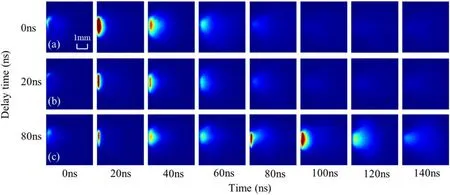
Figure 11.Time-resolved images of the plasma plume with the double-pulse scheme,where the energy of both laser pulses is 150 mJ.
4.Conclusions
In this work,the study of micro-impulse characteristics of an aluminum target ablated in a double-pulse laser scheme was carried out using a nanosecond pulsed laser with a wavelength of 1064 nm.The impulse and the time-resolved images of the plasma plume,corresponding to different delay times,with the double-pulse scheme were obtained using a torsion pendulum and a high-speed camera,respectively.Based on the plasma plume characteristics,the coupling mechanism of impulses generated by ablating the aluminum target using double laser impulses is analyzed.
It is found that the impulse first increases gradually with a delay time between the two pulses when the energy of both laser pulses is 50 mJ.The maximum impulse appears when the delay time is about 60 ns,which is roughly 60% higher compared to the 0 ns delay time impulse.This is due to the heating of the first laser pulse on the aluminum target,which enhances the energy coupling between the second laser pulse and the aluminum target by reducing the reflectivity and ablation threshold of the aluminum target surface.As a result,a second plasma plume with higher intensity and longer duration is produced.With the further increase of the delay time,the interaction between two pulses becomes less and less.Therefore,the impulse decreases gradually to the approximate impulse under 0 ns delay time.
When the energy of both laser pulses is 100 mJ or 150 mJ,the trend of the impulse with the delay time is similar.With the increase in delay time,the impulse decreases first and reaches a minimum when the delay is 20 ns.This is due to the plasma shielding effect generated by the first laser pulse ablation of the aluminum target.The plasma shielding effect reduces the energy coupling between the second laser pulse and the aluminum target,resulting in the weakening of plasma radiation and a shorter plasma duration.With the further increase in the delay time,the impulse increases rapidly and increases to the maximum with the delay time of 80 ns.This is due to the thermal effect acting on the aluminum target surface produced by the first laser pulse,which improves the absorptivity of the aluminum target surface,although the increase of the impulse is less than 10%.When the time delay is greater than 80 ns,the impulse decreases gradually due to the weakness of the interaction between the two pulses.Finally,the impulse approaches the value close to that with the delay time of 0 ns.
In fact,on the one hand,the first laser pulse enables a temporary rise of the target surface temperature with the decreased reflectivity and ablation threshold.On the other hand,the first laser pulse causes the formation of a plasma plume.If a suitable interpulse delay time is chosen,these two effects cooperate to increase the coupling of the second pulse energy with the target surface,so that the total ablated impulse is larger than that in the case of a single pulse of the same total energy.In conclusion,the delay time in doublepulse mode has an important effect on the ablation impulse.This paper provides a reference for the impulse enhancement of laser propulsion with the double-pulse scheme in the application of laser space removal,laser ablation thrusters,detumbling noncooperative targets,and so on.
Acknowledgments
This work is supported by National Natural Science Foundation of China(Nos.11502301 and 11602304).
ORCID iDs
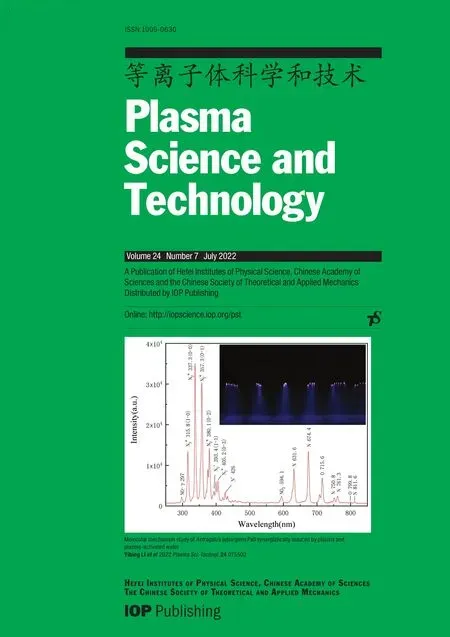 Plasma Science and Technology2022年7期
Plasma Science and Technology2022年7期
- Plasma Science and Technology的其它文章
- Special issue on selected papers from CEPC 2021
- Highly efficient γ-ray generation by 10 PWclass lasers irradiating heavy-ion plasmas
- Surface properties of Al-doped ZnO thin film before and after CF4/Ar plasma etching
- Photoexcited carrier dynamics in a GaAs photoconductive switch under nJ excitation
- Molecular mechanism study of Astragalus adsurgens Pall synergistically induced by plasma and plasma-activated water
- Microwave method based on curve fitting method for high-precision collision frequency diagnosis
